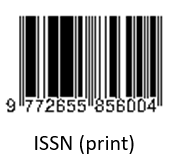Comparison of the mass composition of Coconut Shell in TiO2 towards its characterization for supercapacitor applications
(1) Politeknik Negeri Medan
(2) Politeknik Negeri Medan
(3) Politeknik Negeri Medan
(4) Universitas Prima Indonesia
(*) Corresponding Author
Abstract
This study aims to evaluate the effect of the mass ratio on the capacitance of electrodes made from TiO-based composites. The composites were synthesized using a wet chemical method and applied using the doctor blade technique, incorporating TiO2 and rGO derived from coconut shell activated carbon. Our findings reveal that at a 1:1 mass ratio, the atomic composition of Ti and O was non-uniform, although there was evident adherence of TiO2 elements to the sample surface. In contrast, at mass ratios of 1:3 and 1:5, a decrease in the concentration of Ti atoms and an increase in O atoms were observed, indicating a reduction in Ti oxidation. SEM analysis further revealed that particle size significantly impacts capacitance: smaller particle sizes yielded higher capacitance. In the 1:1 mass variation, the discharge process was protracted, taking up to 29.3 minutes and generating an electrical energy of 0.000413 joules with a capacitance of 489 µF. These insights are pivotal for optimizing the composition and mass ratio, fostering the development of electrode materials characterized by enhanced capacitance and energy efficiency. Such advancements hold promising potential for a range of applications in the energy storage sector.
Keywords: Activated Carbon, Capasitance, Supercapacitor
Full Text:
PDFReferences
R. Lakra, R. Kumar, D. Thatoi, and A. Soam, "Synthesis of TiO2 nanoparticles as electrodes for supercapacitor," Materials Today: Proceedings, vol. 74, pp. 863-866, 2023. [2] S. Sawadsitang, T. Duangchuen, A. Karaphun, T. Putjuso, P. Kumnorkaew, and E. Swatsitang, "Synthesis, characterization and electrochemical properties of activated coconut fiber carbon (ACFC) and CuO/ACFC nanocomposites for applying as electrodes of supercapacitor devices," Surfaces and Interfaces, vol. 25, p. 101174, 2021. [3] J. Jayachandiran et al., "Synthesis and electrochemical studies of rGO/ZnO nanocomposite for supercapacitor application," Journal of Inorganic and Organometallic Polymers and Materials, vol. 28, pp. 2046-2055, 2018. [4] P. Nagaraju, A. Alsalme, A. Alswieleh, and R. Jayavel, "Facile in-situ microwave irradiation synthesis of TiO2/graphene nanocomposite for high-performance supercapacitor applications," Journal of Electroanalytical Chemistry, vol. 808, pp. 90-100, 2018. [5] S. Yousaf et al., "Hierarchically porous CuO microspheres and their r-GO based nanohybrids for electrochemical supercapacitors applications," Journal of Materials Research and Technology, vol. 9, no. 6, pp. 14158-14167, 2020. [6] Y.-H. Son, P. T. Bui, H.-R. Lee, M. S. Akhtar, D. K. Shah, and O.-B. Yang, "A rapid synthesis of mesoporous Mn2O3 nanoparticles for supercapacitor applications," Coatings, vol. 9, no. 10, p. 631, 2019. [7] S. Saini, P. Chand, and A. Joshi, "Biomass derived carbon for supercapacitor applications," Journal of Energy Storage, vol. 39, p. 102646, 2021. [8] X. Xu, J. Gao, Q. Tian, X. Zhai, and Y. Liu, "Walnut shell derived porous carbon for a symmetric all-solid-state supercapacitor," Applied Surface Science, vol. 411, pp. 170-176, 2017. [9] K. Chopngam, M. Luengchavanon, M. Khangkhamano, K. Chetpattananondh, and W. Limbut, "Coating activated carbon from coconut shells with Co3O4/CeO2 for high-performance supercapacitor applications: an experimental study," BioResources, vol. 16, no. 4, p. 8022, 2021. [10] C. Zhang et al., "A Facile Synthesis of TiO2-NiCo2S4-Ti3C2 Electrode material by Hydrothermal Method and its electrochemical performance for Supercapacitor Application," International Journal of Electrochemical Science, vol. 17, no. 9, p. 220925, 2022. [11] M. Diantoro, I. Luthfiyah, H. Wisodo, J. Utomo, and W. Meevasana, "Electrochemical Performance of Symmetric Supercapacitor Based on Activated Carbon Biomass TiO2 Nanocomposites," in Journal of Physics: Conference Series, 2022, vol. 2243, no. 1, p. 012077: IOP Publishing. [12] S. R. A. Sasono, M. F. Rois, W. Widiyastuti, T. Nurtono, and H. Setyawan, "Nanofiber-enrich dispersed activated carbon derived from coconut shell for supercapacitor material," Results in Engineering, vol. 18, p. 101070, 2023. [13] J. Y. Chua, K. M. Pen, J. V. Poi, K. M. Ooi, and K. F. Yee, "Upcycling of biomass waste from durian industry for green and sustainable applications: An analysis review in the Malaysia context," Energy Nexus, p. 100203, 2023. [14] T. Amakoromo, O. Abumere, J. Amusan, V. Anye, and A. Bello, "Porous carbon from Manihot Esculenta (cassava) peels waste for charge storage applications," Current Research in Green and Sustainable Chemistry, vol. 4, p. 100098, 2021. [15] J. Khajonrit et al., "Mangosteen peel-derived activated carbon for supercapacitors," Progress in Natural Science: Materials International, vol. 32, no. 5, pp. 570-578, 2022. [16] A. Murugan, V. Siva, A. Shameem, S. A. Bahadur, S. Sasikumar, and N. Nallamuthu, "Structural and charge density distribution studies on Tin Oxide nanoparticles for Supercapacitor application," Journal of Energy Storage, vol. 28, p. 101194, 2020. [17] A. B. Aritonang, P. Parwaty, M. A. Wibowo, P. Ardiningsih, and A. Adhitiyawarman, "Sintesis TiO2-rGO Dengan Pereduksi Alumunium untuk Fotokatalisis Degradasi Metilen Biru dibawah Irradiasi Sinar Tampak," Equilibrium Journal of Chemical Engineering, vol. 6, no. 2, pp. 150-156, 2023. [18] A. D. Setyoputra, H. Ruffa, H. Sutanto, and A. Subagio, "The Characterisation of MWCNT-rGO-TiO2 Nanocomposite as Potential Electrode Material for Hybrid Supercapacitor," International Journal of Electrochemical Science, vol. 17, no. 5, p. 22053, 2022. [19] F. I. Pasaribu, "Superkapasitor Sebagai Penyimpan Energi Menggunakan Bahan Graphene," RELE (Rekayasa Elektrikal dan Energi): Jurnal Teknik Elektro, vol. 2, no. 2, pp. 65-72, 2020. [20] O. Yoruk, Y. Bayrak, and M. Ates, "Design and assembly of supercapacitor based on reduced graphene oxide/TiO2/polyaniline ternary nanocomposite and its application in electrical circuit," Polymer Bulletin, vol. 79, no. 5, pp. 2969-2993, 2022.
DOI: https://doi.org/10.24071/ijasst.v6i1.7417
Refbacks
- There are currently no refbacks.
Publisher : Faculty of Science and Technology
Society/Institution : Sanata Dharma University

This work is licensed under a Creative Commons Attribution 4.0 International License.











